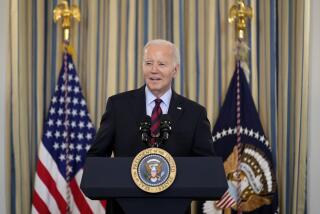A national soda tax is needed to reduce obesity and save lives
- Share via
Now that calorie counts on restaurant menus are a done deal, it’s time to take the next step toward slimming America’s flabby waistline.
A national soda tax.
I know, I know: This is the kind of nanny-state talk that causes seizures among conservatives and libertarians. It’s an intrusion on personal freedom, a trampling of consumer choice, blah-blah-blah.
It’s also, as we’ve learned from taxes on cigarettes and alcohol, a highly effective method of influencing behavior that carries high social costs.
“We like the markets doing the regulation,” said Dr. Robert Lustig, a pediatric endocrinologist at UC San Francisco and a prominent anti-sugar crusader. “But markets can’t regulate substances of abuse. The definition of these substances is that you want them even though you know they’ll ruin your life.”
Where a soda tax can help is in deterring behavior that poses a clear threat to public health — not just in terms of obesity but also Type 2 diabetes, heart disease, cancer, hypertension and other costly ailments.
Last month, Berkeley became the first U.S. city to approve a soda tax, despite the beverage industry’s spending more than $2 million to defeat the measure. The industry was more successful in San Francisco, where it spent more than $9 million beating back that city’s proposed soda tax.
Beginning Jan. 1, Berkeley will levy a 1-cent-per-ounce tax on sugary beverages, including sodas, sports drinks and flavored teas such as Snapple. This will boost the price of a typical can of soda by 12 cents and a two-liter bottle by 68 cents.
A similar measure already had been introduced at the national level by Rep. Rosa DeLauro (D-Conn.). Her proposed Sugar-Sweetened Beverages Tax Act would impose a 1-cent tax for every teaspoon of sugar or caloric sweetener in a drink.
The simple fact is that we consume too much sugar. And much of that sugar comes in the form of high-fructose corn syrup, which is a mainstay of the beverage industry.
Researchers at the Harvard University School of Public Health say that sugary drinks are a “major contributor” to the obesity epidemic, which has resulted in two-thirds of American adults and a third of kids being overweight or obese.
Admittedly, sales of sugary drinks are declining as many consumers turn instead to lower-calorie alternatives. But we have yet to overcome our voracious sweet tooth.
Americans now consume almost 20 teaspoons of sugar every day, according to the National Health and Nutrition Examination Survey database. That’s more than twice the amount recommended for men by the American Heart Assn. and more than three times the recommended amount for women.
A recent study in the American Journal of Clinical Nutrition found that sodas, sports drinks, energy drinks, fruit drinks and other sugary drinks accounted for nearly half of added sugars in U.S. diets.
“If we reduced consumption even a little bit, it would save pounds and it would save lives,” said Mandy Hillstrom, an assistant professor of nutrition at Cal State Los Angeles.
She believes that taxes alone won’t do this and that education is crucial to helping consumers make wise decisions about what they eat and drink.
That’s the rationale behind placing calorie counts on menus. The thinking is that if you know upfront that a large McDonald’s McCafe Chocolate Shake contains 850 calories, you might think twice about ordering it.
Beginning next year, the Food and Drug Administration will require that restaurant chains and vending machine companies with 20 or more locations must post calorie counts on menus and menu boards. Enacting such a rule was included in the 2010 Affordable Care Act.
Hillstrom said the average adult should consume between 1,800 and 2,400 calories a day, depending on size and activity level. A single Mickey D’s shake, in other words, can blow out nearly half your recommended daily allotment.
“That’s where education comes in,” Hillstrom said. “Right now, people don’t even know how many calories they’re supposed to consume.”
Liz Applegate, director of sports nutrition at UC Davis, agreed that “calories” may be an ambiguous term for many consumers. “They don’t understand that it’s an energy value of food,” she said.
Americans are overweight, Applegate said, because “we have more calories going in than we’re putting out.” That is, we’re not getting enough exercise to justify the amount of food we eat, and the result is that we carry all that excess fuel around in the form of fat.
DeLauro’s proposed soda tax, also known as the SWEET Act, is still making its way through Congress, but no one expects it to be approved any time soon. The politically influential American Beverage Assn. already has made clear that it doesn’t like the bill one bit.
“Politicians should focus on what matters most — education, jobs and the economy — and leave the grocery shopping to us,” the organization said. “What goes in your cart is your choice.”
Lustig at UC San Francisco had a ready answer to that.
“Your personal freedom has already been taken away,” he said. “Seventy-four percent of foods available in stores have been spiked with added sugar — for the food industry’s benefit, not yours.”
The beverage industry can whine all it wants about consumer choice, Lustig said. But what they’re really saying is that they should be free to harm people’s health.
“We’re being poisoned,” he said. “When people are being poisoned, you limit it.”
David Lazarus’ column runs Tuesdays and Fridays. He also can be seen daily on KTLA-TV Channel 5 and followed on Twitter @Davidlaz. Send your tips or feedback to david.lazarus@latimes.com.
More to Read
Inside the business of entertainment
The Wide Shot brings you news, analysis and insights on everything from streaming wars to production — and what it all means for the future.
You may occasionally receive promotional content from the Los Angeles Times.











